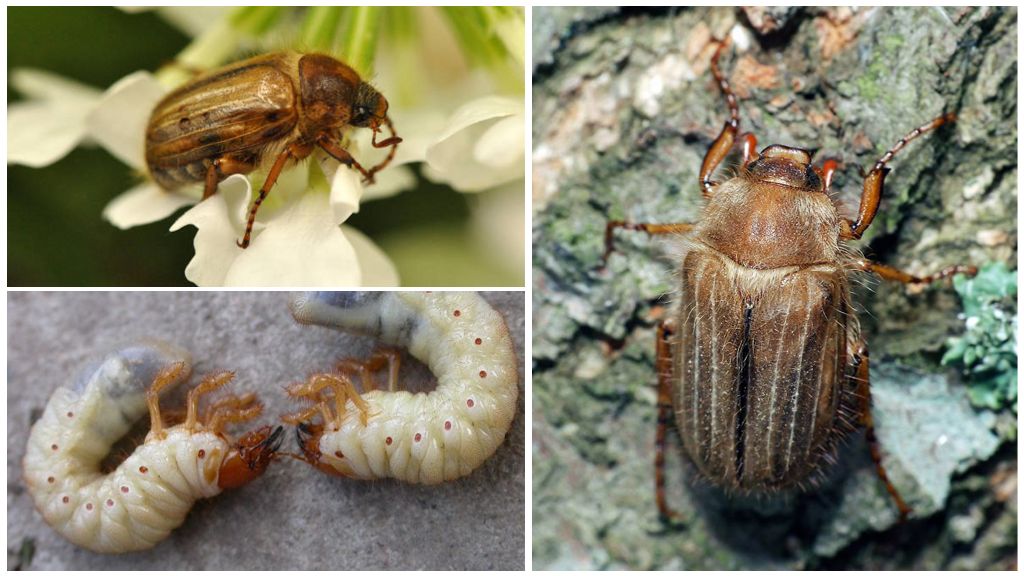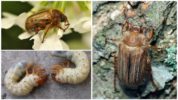- Beetle July Khrushchev
- Beetle July Khrushchev
The July beetle has a scientific name - non-biting (Amphimallon solstitiale). Outwardly similar to cockchafer or Khrushchev, leads a similar lifestyle. It begins active life in late June, ends in early August. It is smaller in size than a regular horsetail, its color is similar. July Beetle is also called Marble Chafer (Polyphylla fullo). The largest representative of the genus in Europe.
What does the July bug look like?
Nekhrushch - an insect of medium size, body length reaches 16 mm. The hard shell is dark brown. Elytra light yellow with longitudinal convex lines, shiny. Legs, antennae reddish. The chest is covered with thick long white villi. The antennae are curly, short. The limbs end with claws.
Interesting!
The marble beetle has an impressive size, an unusual body color. The adult grows up to 40 mm. The body is large, elongated, convex, the carapace is solid, painted in a characteristic marble color. Females of the July Khrushchev are smaller than males and are distinguished by a shorter body. A photo of the July beetle is presented below.
The larva of the marble chafer beetle is long - up to 80 mm, thick, has a body curved with the letter "C". The head is red. No eyes.
Lifestyle
July beetle in our area is widespread. A large generation of Khrushchev is replacing May. It is active from late June to early August. During the day, they hide in the soil, with the onset of twilight crawl out of shelters.
Females are inactive, rarely fly, spend their whole lives on the territory of their birth. Males easily ascend into the air, fly from tree to tree in search of better food. With the first sunshine they burrow into the soil, rest all day. Khrushchev eats marble leaves. Prefers fruit trees, conifers, oak, grapes.

Breeding
The main task of imago is laying eggs. Mating takes place in the evening. The mating season lasts all of July. The female lays about 50 eggs in the soil. After 20 days, white larvae with a red head appear. Initially, their size does not exceed 10 mm, gradually grow up to 40 mm.
Larvae live in the soil, feed on plant roots, periodically shed, increase in size. Until the end of summer, the young variegated khrushchev have time to get stronger, go deep into 1 m, winter. In the spring, when the soil begins to warm up, they are chosen closer to the surface. The next winter, they also have to spend underground in the form of a white greasy worm.
On the third summer, the development of the larva is completed. Pupation occurs. During the week, complex processes take place inside, as a result, a full-fledged marble beetle with a variegated color is selected on the surface.
Harm
July Khrushchev does not bite, like its larvae, does not threaten life, human health. The harm is often associated with the vital activity of the insect, its young. In a few days, a large colony of marble gherkins can destroy a vineyard, apple orchard, and coniferous forest. In life, the situation with the mass destruction of trees does not occur. No harm is felt from the marble beetle. But the most dangerous individuals do not live on trees, but underground.
On a note!
Residents of Germany suffer from attacks of marble beetles of their larvae. In this country, Khrushchev is called the main pest of agricultural crops; they are waging a purposeful fight against it.
In the first year of their life, larvae eat little, but grow rapidly. They feed on the dead root system of grass. Dangerous for crops become at the last stage of their development - the third year. Thick larvae eat the roots of plants, thereby leading to the death of the culture. Seedlings, strawberries, young shrubs, peppers, tomatoes, etc. can suffer from pests.

Methods of struggle
To get rid of a harmful bug in its area, it is necessary to combine several methods of struggle.
- Planted on the perimeter of land fatseliya, blueheads. Plants attract giant wasp, which is a natural enemy of the marble beetle. The wasp looks for a larva under the ground, lays an egg on its body. A few days later, a baby wasp appears, begins to eat its prey.
- Heaps of humus and manure are dug up in the garden. High temperature attracts grubs, little bear, many other pests. In the fall, these heaps are dug up, animals are destroyed.
- One of the methods of protection is planting crops under agrofibre. Adult Khrushchev are not able to lay eggs; they move to another territory. But before using this method, you need to make sure that the site is not infected with the larvae of the marble beetle.
- Digging the soil at the end of summer can save the site from infection. Khrushchev does not lay eggs in the loose earth. In the process of digging the beds, the larvae of the last generation are found, which are located in the upper soil layer. Their destruction will help to avoid the invasion of adults in the spring.
Of the chemical agents for controlling larvae, diazinone-based preparations are most effective. They are brought into the soil when planting seedlings, laid out between rows, beds.





